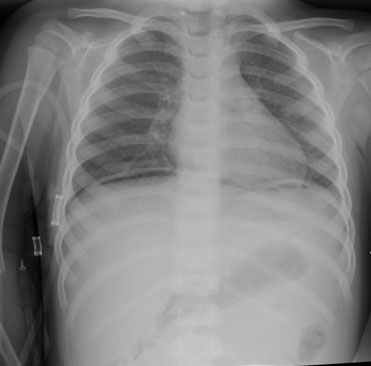A 2.5-year-old boy presents with a history of vomiting at home for the last 24 hours. He was previously healthy except for frequent bruises to his face, chest and abdomen. He recently fell down two steps at the front of his home. His physical exam reveals a tender, distended abdomen. There are bruises on his anterior chest, lower back and forehead, but the abdominal skin is not bruised. His abdominal radiograph reveals the finding demonstrated here:

Accessible Version
A chest and upper abdominal radiograph demonstrating decreased density under the diaphragm, bilaterally.
What is the most likely cause of this finding?
◯
A. Abdominal trauma secondary to the stairway fall.
◯
B. A bowel perforation due to inflicted trauma.
◯
C. Pneumoperitoneum due to a perforated appendicitis.
◯
D. An intussusception associated with Henoch-Schonlein Purpura.
What is the most likely cause of this finding?
◯
A. Abdominal trauma secondary to the stairway fall.
✓
B. A bowel perforation due to inflicted trauma.
◯
C. Pneumoperitoneum due to a perforated appendicitis.
◯
D. An intussusception associated with Henoch-Schonlein Purpura.
The best answer is B
Abdominal injury due to child abuse is frequently missed due to lack of external signs of trauma. Extraluminal air can be seen in this radiograph as dark (air) in spaces just below the diaphragm. In a report by Gaines, bowel perforation due to child abuse was the second most frequent mechanism of injury, following motor vehicle accidents. In this study, isolated duodenal injury was an unusual finding and other injuries were present. A search for other injuries (liver contusions or lacerations, pancreatic trauma, rib fractures, head injuries, etc.) must be undertaken. For further suggestions regarding the work up for physical abuse, click on Evaluation Guidelines for Suspected Child Physical Abuse in the Further Reading list below when abdominal injury is identified in a child who has no history of trauma. In children younger than 3 years of age with no history of a motor vehicle accident and signs of duodenal trauma or perforation, child abuse should be suspected.
Direct trauma to the abdomen can cause a duodenal hematoma or perforation due to the anatomy of the gastrointestinal tract. A direct blow to the epigastrium, such as a punch, kick or stomp, results in injury by tearing the duodenal-jejunal junction at the site of attachment of the ligament of Treitz. The ligament is a band of smooth muscle that extends from this junction to the crus of the diaphragm and functions as a suspensory ligament. The ligament essentially holds the bowel in place so that the force of the trauma causes a tear or contusion. Bowel perforation requires immediate referral for surgical exploration and repair. An abdominal CT scan will help document injuries to other organs, fluid collections and bowel ischemia.
Stairway falls rarely cause intra-abdominal injuries (Huntimer). It is likely that the history of a stairway fall was used by the offender to provide a way to divert attention from the real incident while also enabling the child to get medical attention.
A perforated appendix can present with bowel perforation, but the history should include other factors that lead to a diagnosis of appendicitis. Similarly, Henoch-Schonlein Purpura (HSP) may cause bowel edema and intussusception that results in a perforation, but the history would more likely include episodes of intermittent, crampy abdominal pain. The purpuric lesions of HSP should be differentiated from bruises on clinical examination and generally occur on the lower extremities.
Spontaneous bowel perforation has been described in the literature, but it is unclear whether these reported cases represent missed cases of child abuse.
Further Reading
- Gaines BA, Shultz BS, Morrison K, Ford HR. Duodenal injuries in children: beware of child abuse. Journal of Pediatric Surgery. 2004; 39 (4) : 600-2.PURPOSE: It is frequently overlooked that child abuse may result in significant intraabdominal injury, particularly to the duodenum. The authors hypothesized that a significant number of duodenal injuries in young children would be the result of nonaccidental trauma. METHODS: An 8-year (1995 through 2002) retrospective review of a pediatric level I trauma center database was performed after Institutional Review Board approval was obtained, and information regarding patients with duodenal injury was abstracted. Demographic variables, injury severity, length of stay, mortality rate, and mechanism of injury were examined. Statistical analysis was performed using descriptive statistics and Student's t test. Statistical significance was defined as P less than.05. RESULTS: Over the 8-year study period, 8,968 patients were admitted, 2,179 (24%) were less than 3 years of age. Thirty children (0.3%) suffered injury to the duodenum, with 20 hematomas and 10 perforations. Patients were overwhelmingly boys (80%), with an average age of 7.6 +/- 4.4 years and Injury Severity Score (ISS) of 14 +/- 10. No patients died. Children were injured by a variety of mechanisms, including collisions involving motor vehicles (n = 9), bicycles (n = 4), and ATVs (n = 2). However, all children less than 4 years of age (n = 8) were victims of nonaccidental trauma, 2.8% of all child abuse admissions. Three of these children suffered perforations of the duodenum. Among the entire population, those children who suffered perforations had a significantly higher ISS (23.7 +/- 7.2 v 9.6 +/- 7.3; P <.0003) and longer length of stay (27.1 +/- 15.3 v 12.6 +/- 11.7; P <.007) than those with hematomas CONCLUSIONS: Injury to the duodenum is unusual in the pediatric trauma patient but does result in significant injury severity and prolonged hospitalization. In the young child, one must maintain a high index of suspicion regarding the etiology of the injury, because a large percentage is potentially the result of child abuse.
- Huntimer CM, Muret-Wagstaff S, Leland NL. Can falls on stairs result in small intestine perforations?. Pediatrics. 2000; 106 (2 Pt 1) : 301-5.OBJECTIVE: Abusive parents often report that a fall on stairs resulted in their children's injuries. This review explores whether there is any evidence in the medical literature that a fall on stairs could be a plausible explanation for a small intestine perforation. METHODOLOGY: The English-language medical literature was searched by Medline, for a 29-year period (1970-1998), for reports of the types of injuries sustained in falls on stairs and for reports of the types of blunt abdominal trauma that result in small intestine perforations. Articles that exclusively focused on infant walker injuries or the elderly were excluded. Duodenal, jejunal, and ileal perforations were included, whereas intestinal hematomas and undescribed intestinal injuries were excluded. All types of injuries to the stomach, colon, and rectum were excluded. RESULTS: Falls on stairs were not reported to be a cause for any of the 312 cases of small intestine perforations reviewed. There were no reports of any intraabdominal injuries, including small intestine perforations, in any of the 677 cases of falls on stairs reviewed. Falls on stairs rarely resulted in any type of truncal injury. CONCLUSIONS: Although falls on stairs have been reported to be the most common cause of injury in childhood, no evidence was found to support the contention that an unobstructed fall on stairs could be consistent with perforation of the small intestine.



